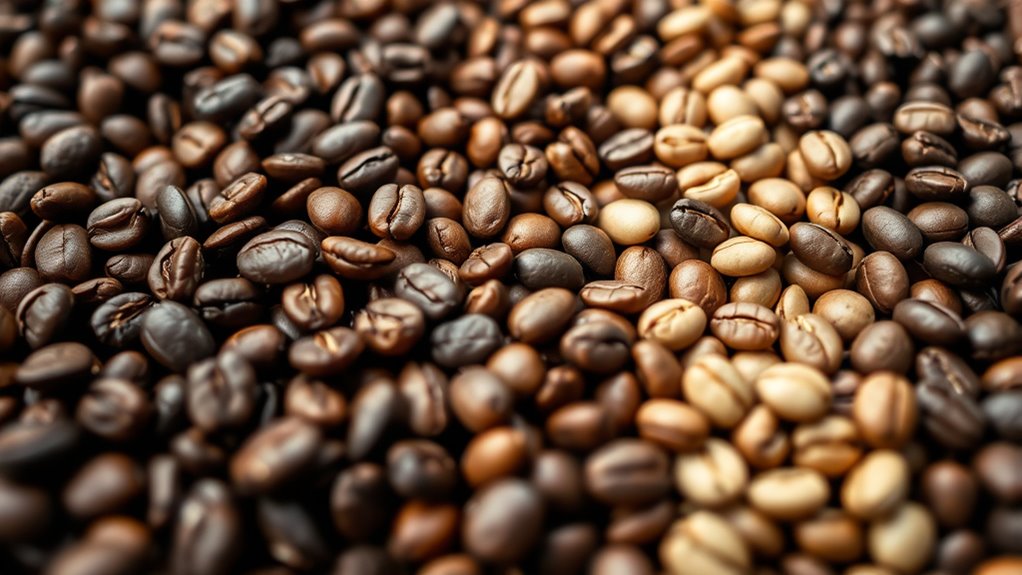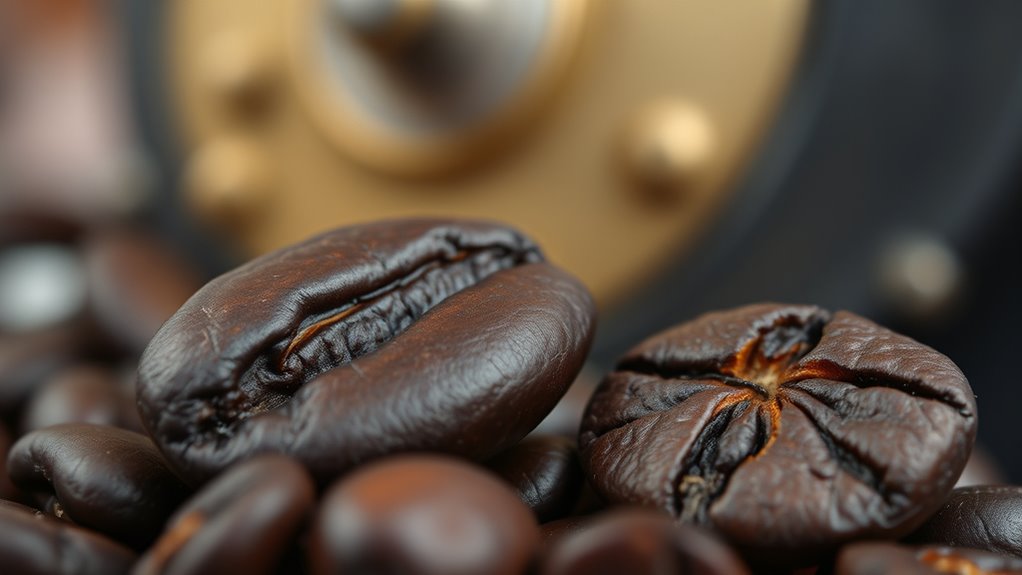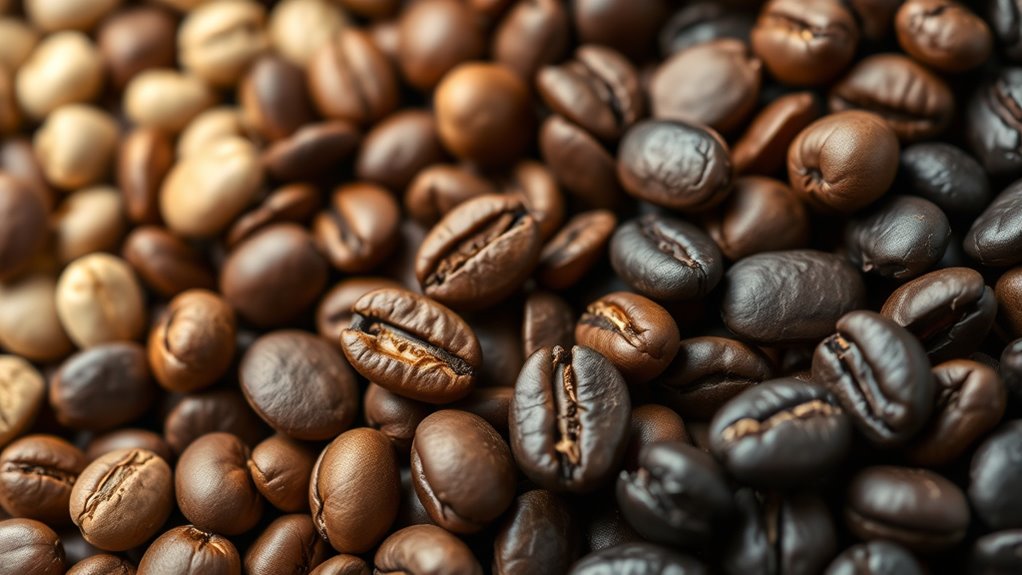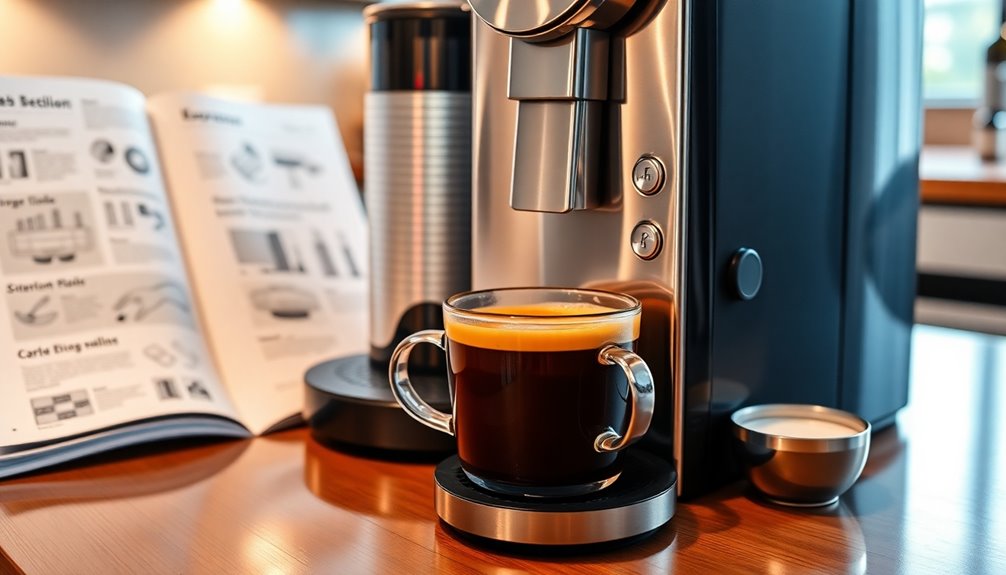When choosing a roast level, consider your flavor preferences and brewing method—darker roasts suit espresso, while lighter ones work better for pour-over. Avoid rushing or over-roasting, and keep an eye on temperature and timing to prevent burnt or uneven beans. Adjust grind size to match your roast and brewing style. By following these do’s and avoiding common pitfalls, you’ll improve your coffee game. Keep exploring to learn more about perfecting your roast levels.
Key Takeaways
- Match roast level with your brewing method for optimal flavor extraction.
- Monitor roasting time and temperature carefully to avoid over or under roasting.
- Avoid rushing the process; develop the roast gradually for even development.
- Adjust grind size according to roast level to enhance flavor and extraction.
- Experiment with different roast profiles to discover your preferred flavor nuances.
Essential Do’s for Choosing the Right Roast Level

To choose the right roast level, you should start by considering your flavor preferences and how you plan to brew your coffee. Your preferred brew method plays a big role; for example, espresso works well with darker roasts, while pour-over complements lighter roasts. Once you know your brewing style, focus on grind size—darker roasts tend to require a slightly coarser grind, whereas lighter roasts benefit from a finer grind to extract ideal flavor. Matching your grind size with your brew method ensures proper extraction and flavor. Keep in mind that lighter roasts preserve more of the beans’ natural acidity and origin characteristics, while darker roasts emphasize bold, roasted flavors. Adjust your grind and roast choice based on your taste and brewing method for the best results. Additionally, understanding the benefits of curiosity can help you explore different roast levels and brewing techniques to find what suits your palate best.
Common Don’ts to Avoid When Roasting Coffee

When roasting coffee, it’s just as important to avoid common pitfalls as it is to follow best practices. Dark roast pitfalls are easy to fall into if you’re not careful, especially over roasting mistakes that can lead to burnt flavors and loss of unique bean characteristics. Don’t rush the process or increase heat too quickly, as this can cause uneven roasting and bitterness. Avoid ignoring your roast development timeline—the temptation to extend roasting time for a darker color often results in over roasting mistakes. Stay attentive and monitor your roast closely, adjusting heat and time as needed. Remember, rushing or neglecting proper temperature control can ruin your roast, so take your time to achieve the desired flavor profile without compromising quality. Additionally, understanding the importance of proper temperature control can help you avoid many common roasting errors.
Frequently Asked Questions
How Does Roast Level Affect Coffee Flavor Complexity?
Roast level considerably impacts coffee flavor complexity by affecting coffee bean chemistry and flavor profile development. As you increase roast level, the beans undergo chemical changes that diminish acidity and highlight roasted, caramelized flavors. Light roasts preserve more of the bean’s original characteristics, offering nuanced flavors and brightness. Dark roasts develop deeper, bolder notes, but can reduce overall complexity. Your choice of roast level shapes the richness and balance in your coffee experience.
Can Roast Level Influence Coffee Acidity and Body?
Yes, roast level influences coffee acidity and body. Lighter roasts preserve acidic brightness, giving you a vibrant, lively flavor. As the roast darkens, the acidity decreases, and the coffee becomes more full-bodied, offering a richer, smoother experience. You’ll notice that darker roasts tend to have a fuller bodied richness, while lighter roasts highlight bright, tangy notes. Adjusting roast level lets you tailor the balance of acidity and body to your preference.
What Equipment Is Best for Achieving Specific Roast Levels?
You might think a fancy commercial roaster is necessary, but your trusty home roaster or even a skillet can do wonders. The key is choosing the right coffee bean selection and roasting equipment that suits your skill level and desired roast. For lighter roasts, a popcorn popper works surprisingly well. For darker levels, invest in a good drum roaster. Remember, the equipment’s just a tool—your technique makes the difference.
How Do I Store Coffee to Preserve Its Roast Level?
To preserve your coffee’s roast level and keep it fresh, store it in an airtight container away from light, heat, and moisture. Avoid refrigeration, as it can cause condensation and spoil freshness. Instead, keep your coffee in a cool, dark place like a pantry. Proper coffee storage helps maintain flavor and aroma, ensuring you enjoy your brew at its best for longer.
Are Certain Roast Levels Better for Specific Brewing Methods?
Yes, certain roast levels pair better with specific brewing methods. Light roasts highlight coffee bean origin’s unique flavors and work well with pour-over or drip brewing, which preserve delicate notes. Medium roasts balance brightness and body, making them versatile for most methods. Dark roasts suit espresso or French press, offering boldness and richness. Choose your roast level pairing based on the brewing method you prefer to enhance your coffee experience.
Conclusion
Choosing the right roast level can elevate your coffee experience, so keep these do’s and don’ts in mind. Did you know that about 80% of coffee drinkers prefer medium roasts? By avoiding common mistakes and following these tips, you’ll enjoy richer, more flavorful brews every time. Experimenting with different roasts helps you find what truly suits your taste buds. So, get roasting wisely and savor the perfect cup every morning!










